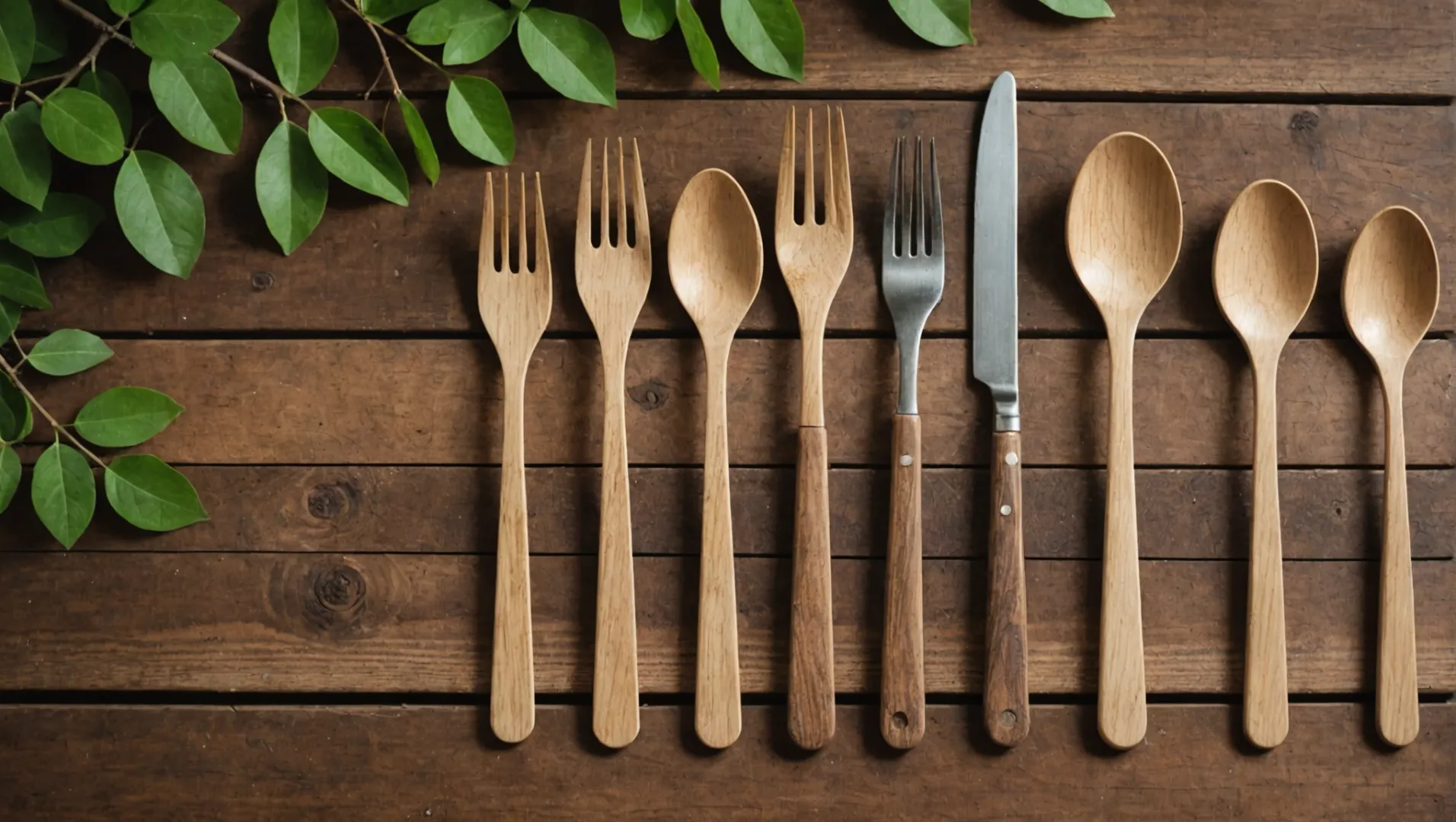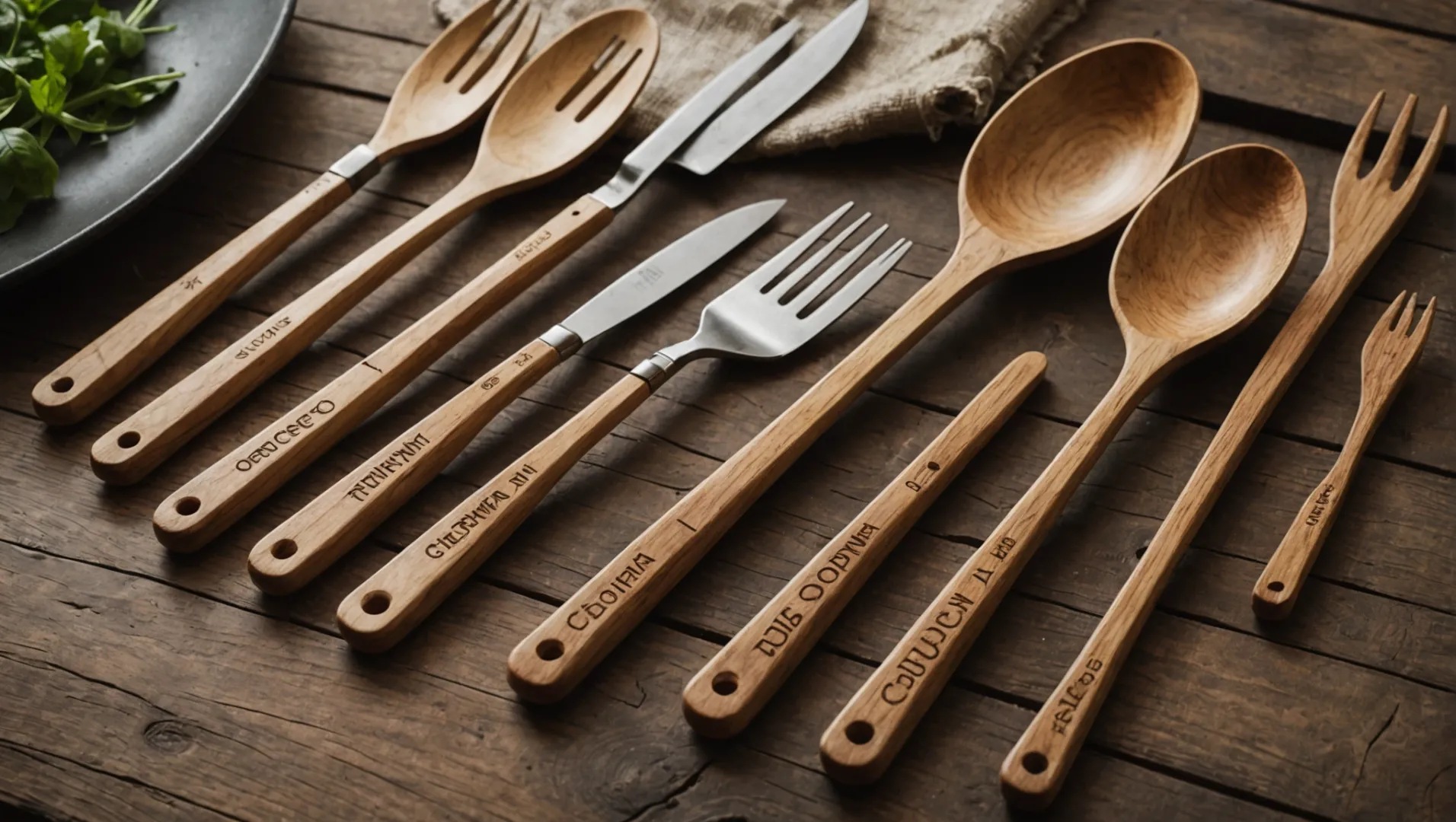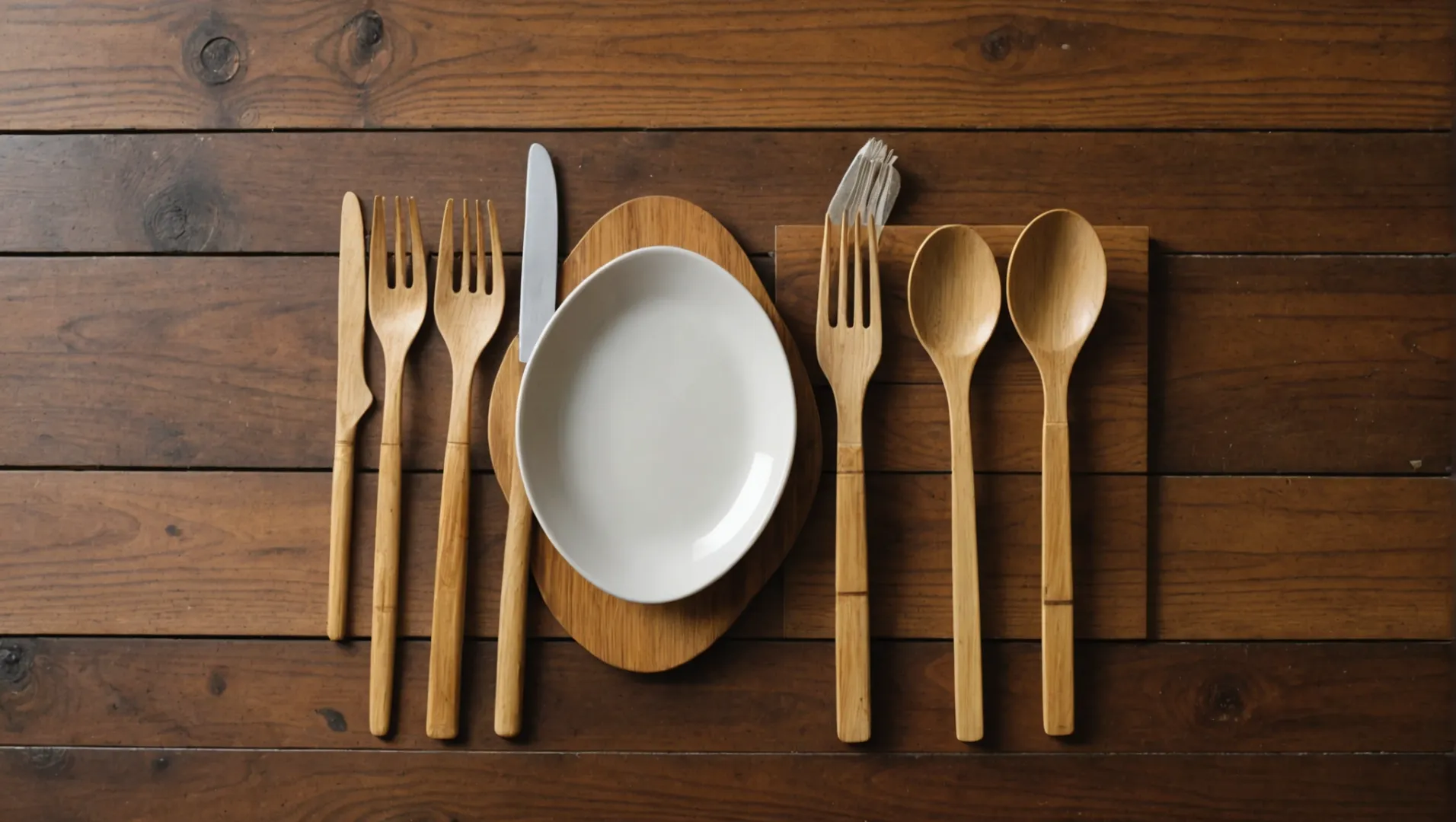
The world is shifting towards sustainability, and wooden cutlery is leading the charge. What exciting innovations lie ahead?
Future innovations in disposable wooden cutlery are likely to include compostable features and multi-functional designs, enhancing their eco-friendliness and usability. These advancements aim to offer sustainable alternatives to plastic utensils by improving biodegradability and adding versatile functionalities.
While these initial insights provide a glimpse into the future of wooden cutlery, there's much more to explore. From material sourcing to design improvements, let's delve into how these innovations can revolutionize everyday dining experiences.
Wooden cutlery is more eco-friendly than plastic cutlery.True
Wooden cutlery is biodegradable and sourced sustainably, reducing pollution.
How Do Compostable Features Enhance Wooden Cutlery?
Discover how compostable features in wooden cutlery offer eco-friendly benefits beyond traditional designs.
Compostable features in wooden cutlery enhance its environmental impact by enabling faster decomposition, reducing landfill waste, and ensuring the cutlery returns to nature harmlessly. These features often include biodegradable coatings and materials that support sustainable waste management practices, making them an ideal choice for eco-conscious consumers.

Enhancing Biodegradability with Compostable Coatings
One of the primary ways compostable features enhance wooden cutlery is through the use of biodegradable coatings. These coatings, often derived from plant-based sources, protect the wood while ensuring the cutlery can decompose quickly after disposal. For instance, a natural wax coating1 not only acts as a barrier against moisture and bacteria but also breaks down easily in a composting environment. This means that once the cutlery is discarded, it starts its journey back to the earth without leaving harmful residues.
Reducing Landfill Waste
The integration of compostable features directly addresses landfill waste reduction. Unlike plastic utensils, which can linger in landfills for centuries, wooden cutlery with compostable enhancements decomposes within months. This rapid breakdown significantly reduces the volume of waste clogging landfills and contributes to a cleaner environment. By choosing compostable wooden cutlery, consumers can actively reduce their environmental footprint.
Supporting Sustainable Waste Management
Compostable wooden cutlery supports sustainable waste management practices by aligning with modern composting facilities. These facilities are equipped to process biodegradable materials efficiently, turning what would be waste into valuable compost that enriches soil health. With increasing regulations on waste disposal, composting solutions2 for cutlery are becoming a practical and preferred option for municipalities and businesses alike.
Enhancing Consumer Appeal
Consumers are increasingly drawn to products that promise environmental benefits. Compostable wooden cutlery not only fulfills this demand but also serves as an educational tool to promote sustainable living practices. Brands that offer these eco-friendly options can leverage this appeal by marketing their products as both practical and planet-friendly solutions, encouraging consumers to participate in waste reduction actively.
Innovations in Material Composition
Recent innovations have explored combining wood with other biodegradable materials like bamboo fibers or starches. These hybrids not only enhance strength and durability but also improve compostability. Such materials ensure that the cutlery maintains its functionality throughout its use while offering an accelerated decomposition rate post-disposal.
Incorporating compostable features in wooden cutlery is more than just a trend; it's a necessary evolution towards sustainable dining solutions. By embracing these advancements, we pave the way for a future where our everyday choices positively impact the planet.
Compostable cutlery decomposes faster than plastic.True
Compostable wooden cutlery breaks down in months, unlike plastic.
Biodegradable coatings harm the composting process.False
Biodegradable coatings aid decomposition, not hinder it.
Can Multi-Functional Designs Improve Usability of Wooden Utensils?
Wooden utensils are not just eco-friendly; they can be versatile too. How does design innovation enhance their usability?
Yes, multi-functional designs can significantly improve the usability of wooden utensils by integrating additional features that enhance their practicality, such as ergonomic handles or built-in measuring tools, thus making them more appealing and useful for everyday tasks.

Exploring Multi-Functional Design Concepts
The concept of multi-functional design in wooden utensils is gaining traction as manufacturers strive to meet both aesthetic and practical needs. Imagine a wooden spoon that doubles as a spatula or a fork with a built-in knife edge. These designs are tailored to provide users with versatile tools that simplify cooking and dining experiences. By incorporating multiple functions into a single utensil, designers aim to reduce clutter and make kitchen tasks more efficient.
Ergonomic Enhancements
One area where multi-functional design shines is in ergonomics. Wooden utensils can be crafted with contoured handles that fit comfortably in the user's hand, reducing fatigue during prolonged use. This is particularly beneficial for individuals with arthritis or limited hand mobility. Moreover, handles can be designed with grooves or textures to prevent slipping, even when wet.
Incorporating Measurement Tools
Another innovative approach is embedding measurement tools within the utensil itself. For example, a wooden spatula might feature etched measurement marks along its edge, allowing cooks to measure ingredients directly while stirring. This eliminates the need for separate measuring spoons or cups, streamlining the cooking process.
Benefits of Multi-Functional Wooden Utensils
Multi-functional wooden utensils not only enhance usability but also promote sustainability. By combining functions, fewer resources are needed to produce multiple utensils. Additionally, these designs encourage minimalism in the kitchen, aligning with modern eco-conscious lifestyles.
To illustrate, a comparison table can be helpful:
| Feature | Traditional Utensils | Multi-Functional Utensils |
|---|---|---|
| Resource Usage | High | Low |
| Usability | Single Purpose | Versatile |
| Kitchen Clutter | More | Less |
These benefits extend beyond individual households. In commercial kitchens, where space and efficiency are paramount, using utensils that serve multiple purposes can lead to significant improvements in workflow and resource management.
Challenges and Considerations
Despite their advantages, multi-functional wooden utensils must overcome certain challenges. Durability is a major concern; incorporating multiple functions can sometimes compromise the structural integrity of the utensil. It is essential for manufacturers to use high-quality wood and apply finishes that protect against wear and tear.
Moreover, there is a need for consumer education on the proper use and maintenance of these advanced designs. Providing care instructions ensures longevity and hygiene, maintaining the utensil's functionality over time.
In conclusion, while multi-functional designs hold great potential for improving the usability of wooden utensils, attention to material quality and user education remains crucial to their success. As these innovations continue to evolve, consumers can expect more versatile and sustainable options in their kitchenware arsenal.
Multi-functional wooden utensils reduce kitchen clutter.True
They combine functions, minimizing the need for multiple tools.
Ergonomic designs increase fatigue in wooden utensil use.False
Ergonomic designs decrease fatigue by improving comfort and grip.
What Are the Environmental Impacts of Wooden vs. Plastic Cutlery?
As we become more eco-conscious, the debate between wooden and plastic cutlery intensifies. Which is truly better for our planet?
Wooden cutlery is environmentally superior to plastic due to its biodegradability and sustainable sourcing, reducing pollution and resource consumption. However, responsible production and disposal are crucial for minimizing environmental impacts.

The Lifecycle of Cutlery: From Production to Disposal
The environmental impact of both wooden and plastic cutlery begins at the production stage. Wooden cutlery is typically crafted from renewable resources like birch or bamboo, often sourced from sustainably managed forests3. This ensures that the raw materials are replenished, maintaining ecological balance. In contrast, plastic cutlery is derived from non-renewable petroleum, whose extraction and processing contribute significantly to greenhouse gas emissions.
When considering disposal, wooden cutlery holds a clear advantage. It is biodegradable and can be composted, meaning it breaks down naturally without leaving harmful residues. Plastic cutlery, however, can take centuries to decompose, often ending up in landfills or oceans, where it poses threats to wildlife and ecosystems.
Energy Consumption and Pollution
Energy consumption is another critical factor. The production of plastic utensils involves energy-intensive processes that release pollutants into the atmosphere. Wooden cutlery manufacturing, although not entirely devoid of energy use, generally requires less processing and involves fewer emissions.
A comparative table below illustrates the key differences:
| Factor | Wooden Cutlery | Plastic Cutlery |
|---|---|---|
| Material Source | Renewable (wood, bamboo) | Non-renewable (petroleum) |
| Biodegradability | High | Very low |
| Energy Consumption | Moderate | High |
| Pollution | Minimal (if sustainably sourced) | Significant (during production & disposal) |
The Role of Certifications and Innovations
Eco-certifications play a vital role in ensuring the environmental friendliness of wooden cutlery. Certifications such as FSC4 confirm that the wood is sourced responsibly, aligning with environmental standards. Meanwhile, innovations in coatings for wooden utensils enhance their biodegradability and usability, supporting sustainable dining practices.
Plastic cutlery lacks these benefits, as even biodegradable plastics can leave microplastic residues that affect soil and marine life. Moreover, innovations in plastic cutlery tend to focus on reducing costs rather than environmental impact.
Consumer Influence and Market Dynamics
Consumers play a significant role in shaping the future of cutlery through their purchasing decisions. As demand for sustainable options grows, manufacturers are incentivized to innovate in eco-friendly products. This trend is evident as more companies invest in research for compostable wooden cutlery5, aiming to meet consumer expectations while adhering to stricter environmental regulations.
In summary, while wooden cutlery presents a more sustainable choice compared to plastic, its benefits are maximized only when sourced responsibly and disposed of properly. As awareness increases and innovations continue, wooden cutlery can significantly reduce our ecological footprint.
Wooden cutlery is biodegradable and compostable.True
Wooden cutlery breaks down naturally, leaving no harmful residues.
Plastic cutlery decomposes faster than wooden cutlery.False
Plastic cutlery takes centuries to decompose, unlike wooden cutlery.
How Can Consumers Influence the Development of Sustainable Cutlery?
Consumers hold significant power in shaping the future of sustainable cutlery through informed choices and advocacy.
Consumers can influence sustainable cutlery development by prioritizing eco-friendly products, supporting ethical brands, and advocating for sustainable practices. This demand drives companies to innovate, ensuring that sustainability becomes a core focus in cutlery production.

The Power of Consumer Choice
Every purchase decision impacts the market. When consumers prioritize eco-friendly cutlery options6, they send a clear message to manufacturers about their preferences. This demand encourages companies to invest in sustainable materials and production methods. Brands are more likely to innovate with biodegradable and reusable materials if there is evident consumer interest.
Supporting Ethical Brands
Choosing to buy from brands with strong sustainability practices further drives market change. Consumers can research which companies use responsibly sourced materials, such as FSC-certified wood, or utilize sustainable manufacturing processes7. By supporting these companies, consumers reward ethical practices and push other brands to adopt similar standards.
Advocacy and Awareness
Beyond purchasing decisions, consumers can influence the development of sustainable cutlery through advocacy. This includes promoting awareness about the benefits of sustainable products among peers and engaging in environmental campaigns8. By participating in discussions or supporting legislation that favors sustainability, consumers can effect broader change.
Feedback and Demand for Transparency
Consumers should demand transparency from companies regarding their supply chains and production processes. By asking for detailed information on how products are made, consumers encourage brands to improve their practices. Feedback mechanisms, such as reviews or direct communication with companies, allow consumers to express their preferences clearly.
Example of Consumer Influence
Consider how consumer pressure led to the reduction of single-use plastics in various sectors. Similar advocacy could elevate sustainable cutlery to a mainstream option. For instance, a collective push for compostable features in wooden cutlery could reduce landfill waste significantly.
| Consumer Action | Impact on Cutlery Development |
|---|---|
| Prioritizing eco-friendly options | Encourages biodegradable innovation |
| Supporting ethical brands | Rewards sustainable practices |
| Advocating for transparency | Promotes ethical sourcing |
| Providing feedback | Drives design improvements |
By understanding their influence, consumers can play a pivotal role in shaping a more sustainable future for cutlery. As more individuals become conscious of their environmental impact, the collective demand for eco-friendly solutions will drive significant industry advancements.
Consumers can drive sustainable cutlery innovation.True
Consumer demand for eco-friendly options encourages companies to innovate.
Supporting unethical brands promotes sustainable cutlery.False
Unethical brands often do not prioritize sustainability, hindering progress.
Conclusion
Embracing innovations in wooden cutlery leads us toward a sustainable future where our daily choices positively impact the planet.
-
Learn how natural wax coatings enhance durability and eco-friendliness.: Wax is a tenacious substance; it also never fully dries and is capable of both covering and resisting most everything. ↩
-
Discover the process behind transforming biodegradable cutlery into soil-enriching compost.: Compostable utensils are ones that are made of natural materials, such as cornstarch or potato starch. They are still a type of plastic. ↩
-
Learn about how sustainable forest management supports eco-friendly cutlery.: In theory, wooden utensils are always sustainably sourced because wood is a renewable resource that can be replaced by planting new trees. ↩
-
Discover why FSC certification ensures responsible wood sourcing.: FSC certification ensures that products come from responsibly managed forests that provide environmental, social and economic benefits. ↩
-
Explore new advancements making wooden cutlery more compostable.: Compostable cutlery made from PLANT BASED materials. World Centric Cutlery and natural Birch wood cutlery. Free Shipping over $89. ↩
-
Discover diverse eco-friendly cutlery options available for conscious consumers.: The most eco friendly disposable cutlery is natural Birch Wood cutlery from Green Paper Products. Made from sustainably sourced natural Birch wood, this cutlery ... ↩
-
Explore sustainable manufacturing methods that reduce environmental impact.: Reducing, reusing, and recycling should be central to knife manufacturing. Clever design choices can ensure that waste from produced knives, ... ↩
-
Find campaigns that advocate for eco-friendly product adoption.: These ten impactful sustainable marketing campaigns serve as powerful examples of how brands can use their influence to champion causes, convey meaningful ... ↩

